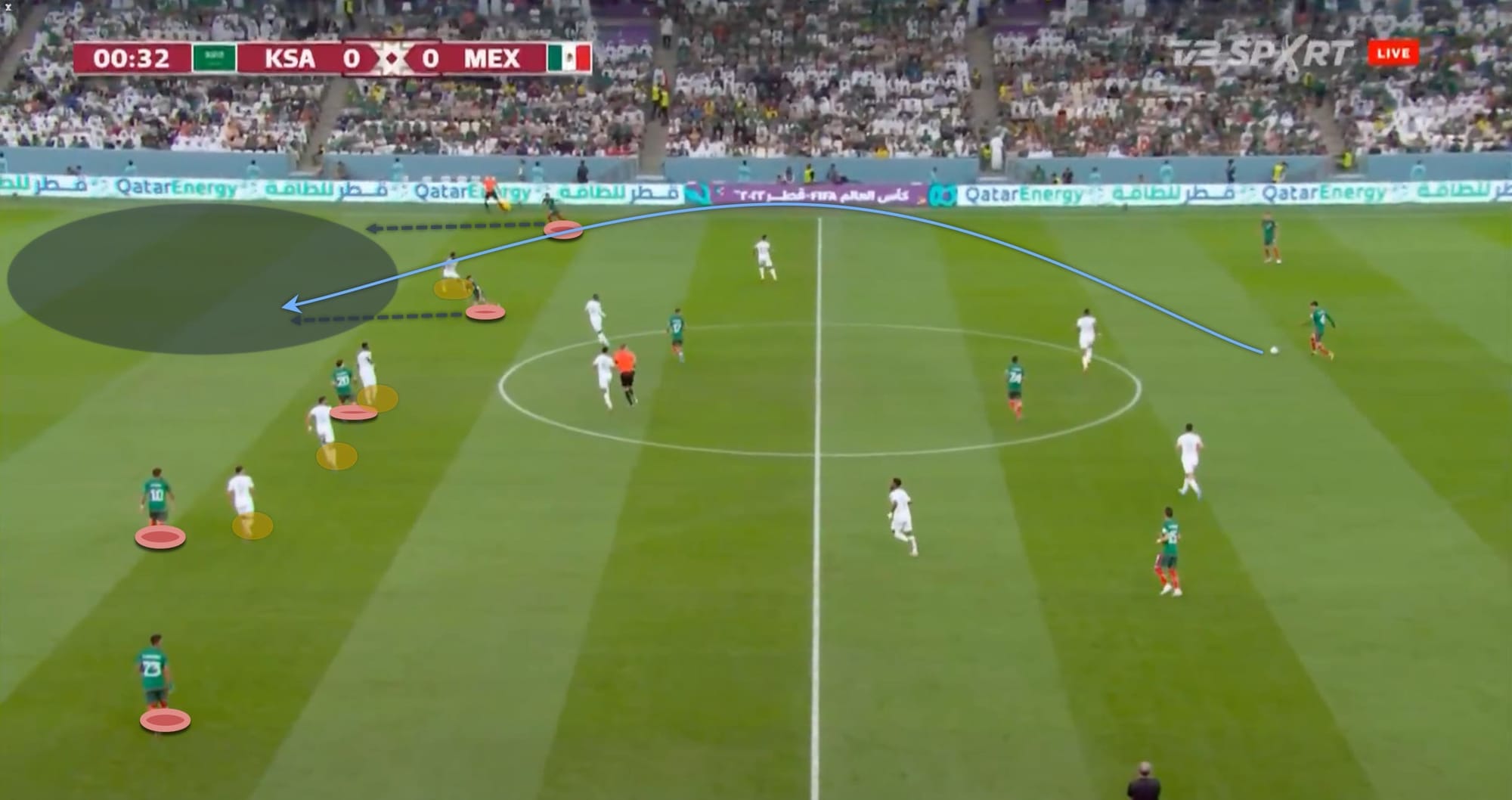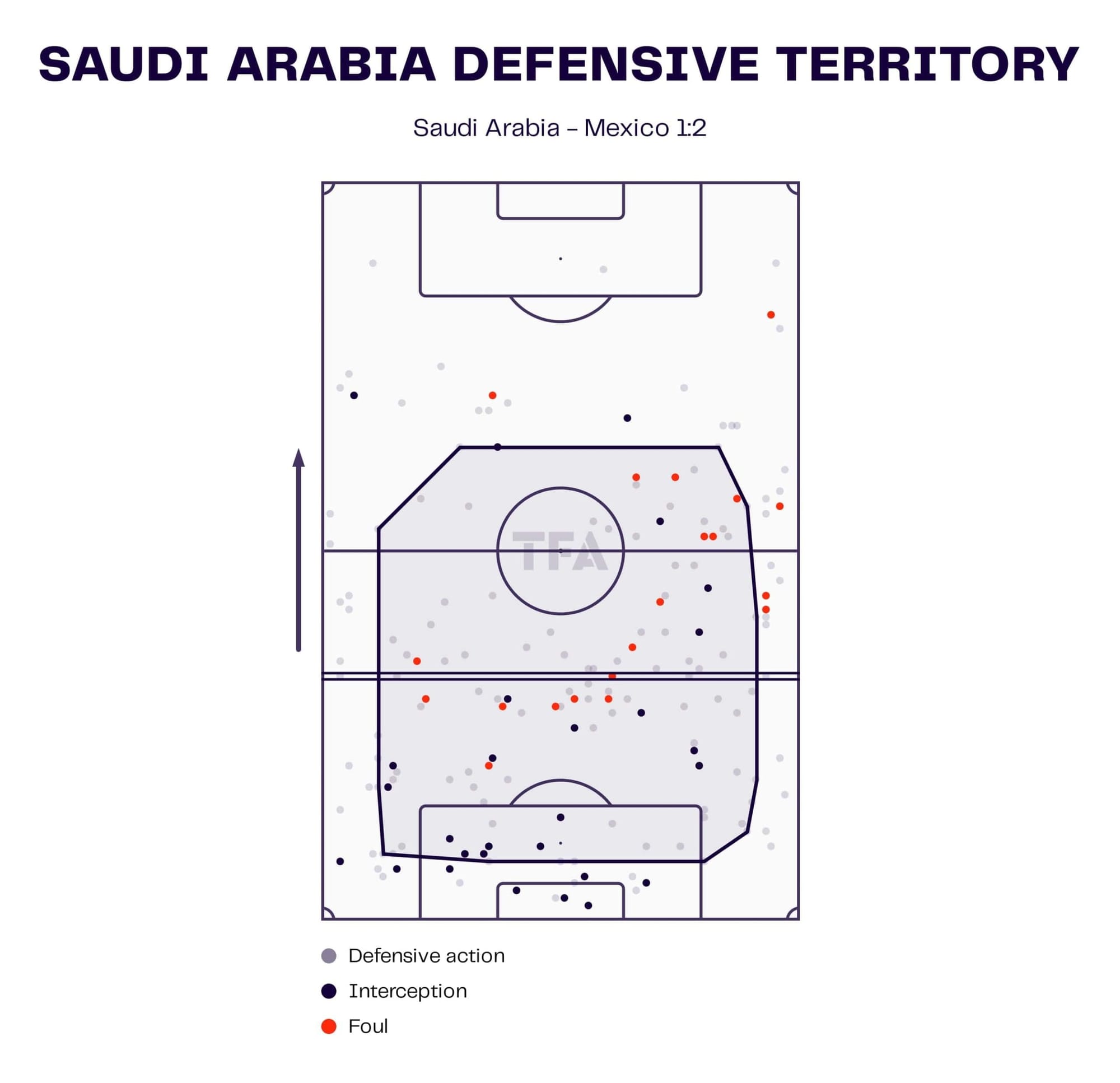After defeating Argentina in the opening game, Saudi Arabia went on to lose 2-0 against Poland’s Robert Lewandowski. On the other hand, Mexico was on the losing end, securing just a tie against Poland with one point on the board. Mexico won the game but were eliminated due to the goal difference with just one goal below Poland.
Despite having the opportunity to continue to the knockout stages, both teams drowned out each other, enabling Argentina and Poland to proceed. Despite losing, Saudi Arabia’s only goal proved heartbreaking for the Mexicans.
This tactical analysis will reveal how Mexico fell one goal shy of qualifying for the round of 16 after defeating Saudi Arabia. We will also look at the tactics used by both managers.
Lineups
Hervé Renard proceeded with his preferred 4-4-2 formation vs Mexico in his third group-stage encounter. He made a few changes to the starting eleven to acquire a lot better grasp of the concept. Mohammed Al-Owais began between the sticks as he has been in exceptional form in the World Cup. Abdulelah Al-Amri and Al-Tambakti, the 23-year-old covered the centre of defence accompanied by Ali Al-Bulaihi on the left and Sultan Al-Ghanam on the right.
Saud Abdulhamid, the 23-year-old joined Ali Al-Hassan to form the centre midfield. Saleh Al-Shehri and Mohammed Kanno played as the right and left forwards with Firas Al-Buraikan and Salem Al-Dawsari, the number 10 on the right and the left wing.

Former Barcelona manager Martino had employed the same formation he had used against Poland in the previous game. It was a hybrid 4-2-3-1 with just one alteration to the starting eleven as the Atletico Madrid star Héctor Herrera, was replaced by Orbelín Pineda in the middle. As usual, it was Francisco Ochoa in the goal with César Montes and Héctor Moreno as the centre-backs. Jesús Gallardo and Jorge Sánchez were left undisturbed in the starting eleven.
Luis Chávez and the Ajax star Edson Álvarez began as the pivots in front of the defensive line with Pineda immediately above them and tucked in behind the centre-forward to construct a triangle. Ernesto Vega and Hirving Lozano manned the left and right sides with Henry Martín as the sole striker.
Mexico’s Abundant Overloads
Gerardo Martino, the manager of Mexico, has been disappointed with his team’s performance in previous matches going up to the World Cup. The team’s failure to contend with opponents of a higher calibre can be seen in the past four games, which saw two wins against Iraq and Peru and two losses to Sweden and Colombia. This unquestionably had a greater impact on Mexico’s World Cup campaign.
By depleting the flanks, the Mexicans swiftly took control of Saudi Arabia’s organisation. The fullbacks, Gallardo and Sánchez, stayed quite high to provide width while trying to get through the defence. Mexico benefited from this in several ways, although sweeper keeper Al-Owais refuted it. An example of the aforementioned situation is shown below.

Only 32 seconds into the game, the full-backs followed Martino’s instructions and positioned themselves high up. They then overloaded Saudi’s fullbacks and attacked the wide space on the sides. This undoubtedly helped Mexico to breeze through the mid-block and into the final third.

The employment of full-backs when Álvarez lowers to a three-man defence and Chávez adopts the role of centre-defensive midfielder speaks for itself. This creates room for Sánchez and Gallardo to exploit in deep.

In the image above, Mexico’s midfield is tight and stable, with each player covering the duel in some fashion. This structure enabled them to retrieve the ball with precision. The triangle created by the attacking midfielders and the right-back, Sánchez, is likewise shown in the above image.

The graphic above depicts the total number of carries as well as the number of carries into the penalty box. Mexico had 32 penetrating carries, which was nearly their highest total in a game. This demonstrates how badly Mexico desired to advance to the knockout stages.

In the latter phases, Mexico intended to attack with crosses. However, Mexico was not a great crossing team, making it difficult to satisfy the manpower requirements inside the box. Mexico’s crosses were ineffective, and the players seemed to do little except follow orders. Thus, they found it hard to create goal-scoring opportunities through crosses.

Mexico also had the greatest xG value during the World Cup versus Saudi Arabia. The xG was 2.95, indicating that their third goal was just around the corner. Despite Al-Owais’ several saves, the Mexicans were unable to score past him on the field of play.
Saudi Arabia’s Inability
Saudi Arabia’s manager, Hervé Renard, on the other hand, has given life to the country’s excitement for the sport. His performance against Argentina showed the world what he is capable of, paving the way for the country’s first-ever triumph against the South American powers. His team’s most recent match before heading to Qatar ended in a 1-0 loss against the previous edition’s runners-up, Croatia. After that, his squad overcame Iceland and tied with Panama and Honduras.
Although Saudi scored in the last minutes to crush the Mexicans’ hopes, they only troubled the defence a few times. The only way to get through Mexico’s defences was to launch counterattacks, which they struggled to execute.

The graphic above depicts a counter-attacking opportunity that Saudi Arabia failed to capitalise on. The framework created in the last third was insufficient to allow for rapid combinations to advance. After gaining the ball in midfield, the players were not properly positioned to break past Mexico’s defence.

Saudi Arabia’s defensive lineup was not very strong, allowing the Mexicans to easily break the chain. The picture above shows that they formed a five in the rear and a diamond shape in the front. This provided vast amounts of room for the large regions to utilise. Although, for the most part, they seemed to retain this framework throughout the first half. This provided the Mexicans ample time to settle in and devise pass combinations to continue attacking.

The above image depicts the inability to generate final-third combinations that challenge the goalkeeper. The team’s exuberance was dampened by their failure to create pass combinations in the final third.
In the aforementioned situation, Saud, who can be seen slightly above Mexico’s right defence, was unable to locate the correct ball for the sprinting midfielder. The players’ intensity in the last third was insufficient to get past Mexico’s defence.

Mexico put Saudi Arabia’s defence to the ultimate test, as seen in the above image. There are endless defensive actions in one’s half. Although there are multiple interceptions in the picture, they did not lead to counter-attacks; rather, Mexico’s recovery was extensive.

The graphic above proves how Mexico was able to counter-press and retake possession of the ball. Within five seconds after losing possession, there were 23 recoveries in the whole game.
Conclusion
Saudi Arabia’s defence was often breached by Mexico, although only two goals were both set-pieces as a result. According to the statistics, Mexico made 26 total shots, including an incredible 11 on goal. Only 2 of the 10 threats Saudi Arabia made against Ochoa hit its target. Mexico controlled the ball for over 61% of the game, while Saudi Arabia had 39% of it. With so many opportunities provided by Mexico, the game was nearly entirely one-sided.
The two subheadings that were discussed in the analysis were the main causes of Mexico’s victory and the lack of further scoring to qualify for the round of sixteen. Unfortunately, neither team managed to place in the top two in their group, and both were eliminated from the competition.





Comments